Related Research Articles
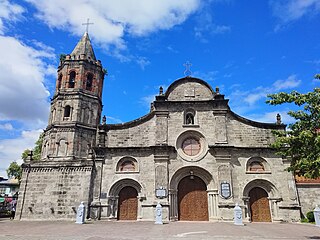
Bulacan, officially the Province of Bulacan, is a province in the Philippines located in the Central Luzon region. Its capital is the city of Malolos. Bulacan was established on August 15, 1578, and part of the Metro Luzon Urban Beltway Super Region.

San Jose del Monte, officially the City of San Jose del Monte, is a 1st class component city in the province of Bulacan, Philippines. According to the 2020 census, it has a population of 651,813 people, making it the largest local government unit within the province of Bulacan and Central Luzon, and the 18th most populated city in the Philippines.
Classical swine fever (CSF) or hog cholera is a highly contagious disease of swine. It has been mentioned as a potential bioweapon.

Bustos, officially the Municipality of Bustos, is a 2nd class municipality in the province of Bulacan, Philippines. According to the 2020 census, it has a population of 77,199 people.

Pandi, officially the Municipality of Pandi, is a 2nd class municipality in the province of Bulacan, Philippines. According to the 2020 census, it has a population of 155,115 people.

Pulilan, officially the Municipality of Pulilan, is a 1st class municipality in the province of Bulacan, Philippines. According to the 2020 census, it has a population of 108,836 people.

San Miguel, officially the Municipality of San Miguel, is a 1st class municipality in the province of Bulacan, Philippines. According to the 2020 census, it has a population of 172,073 people.
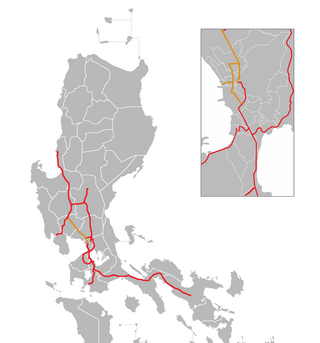
The North Luzon Expressway (NLEX), signed as E1 of the Philippine expressway network, partially as N160 of the Philippine highway network, and R-8 of the Metro Manila arterial road network, is a controlled-access highway that connects Metro Manila to the provinces of the Central Luzon region in the Philippines. The expressway, which includes the main segment and its various spurs, has a total length of 101.8 kilometers (63.3 mi) and travels from its northern terminus at Sta. Ines Interchange to its southern terminus in Balintawak Interchange, which is adjacent to its connection to Skyway, an elevated toll road that connects the NLEX to its counterpart in the south, the South Luzon Expressway. The segment of the expressway between Santa Rita Exit in Guiguinto and the Balintawak Interchange in Quezon City is part of Asian Highway 26 of the Asian highway network. Despite that the name stating the word "North Luzon", the expressway only ends at Sta. Ines Exit at Mabalacat, Pampanga which is located in Central Luzon.

African swine fever virus (ASFV) is a large, double-stranded DNA virus in the Asfarviridae family. It is the causative agent of African swine fever (ASF). The virus causes a hemorrhagic fever with high mortality rates in domestic pigs; some isolates can cause death of animals as quickly as a week after infection. It persistently infects its natural hosts, warthogs, bushpigs, and soft ticks of the genus Ornithodoros, which likely act as a vector, with no disease signs. It does not cause disease in humans. ASFV is endemic to sub-Saharan Africa and exists in the wild through a cycle of infection between ticks and wild pigs, bushpigs, and warthogs. The disease was first described after European settlers brought pigs into areas endemic with ASFV, and as such, is an example of an emerging infectious disease.
Double-dead meat is the Filipino appellation for meat taken from an animal that has died of disease. The appropriate method of dealing with diseased hog carcasses is disposal by burial or burning. Illegally slaughtered meat is also referred to as hot meat or botcha.

Radial Road 8, more commonly referred to as R-8, is a network of roads and bridges that altogether form the eighth radial road of Manila in the Philippines. It runs north-south through northern Metro Manila linking the City of Manila with Quezon City, Caloocan, and Valenzuela into the northern provinces of Bulacan, Pampanga, Tarlac, Pangasinan, and La Union. The portion of R-8 between Guiguinto and Balintawak is also designated a component of the Pan-Philippine Highway network (AH26). It also has a spur segment in Quirino Highway from NLEX to its junction with R-7 at Commonwealth Avenue, both in Quezon City.
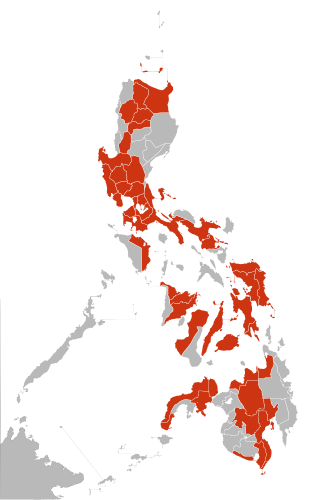
The 2009 flu pandemic in the Philippines began on May 21, 2009, when a young Filipina girl first contracted the A(H1N1) virus while in the United States. In the following days, several local cases were reported to be caused by contact with two infected Taiwanese women who attended a wedding ceremony in Zambales.

The Candaba Viaduct is a 5-kilometer (3.1 mi) viaduct carrying the North Luzon Expressway (NLEX) across the Candaba Swamp in the provinces of Pampanga and Bulacan, Philippines consisting of six lanes. It was the longest bridge in the Philippines upon its opening in 1976, surpassed in April 27, 2022 by the 8.9 km Cebu–Cordova Link Expressway (CCLEX) upon its inauguration making the viaduct now the second longest bridge in the country. The viaduct was designed by Aas-Jakobsen and built by Construction Development Corporation of the Philippines as part of construction of the whole NLEX.
Felipe Salvador, also known as Apo Ipe or Ápûng Ipê Salvador, was a Filipino revolutionary who founded the Santa Iglesia, a messianic society that was categorized as "colorum" which had the aim of defeating and overthrowing the occupational government of the United States in the Philippines. Salvador joined the Katipunan in 1896 upon the arrival of the Katipuneros from Balintawak in Baliuag, Bulacan. He founded the Santa Iglesia in 1901 after fleeing to the mountains when Gen. Emilio Aguinaldo was captured by American troops. Salvador and his church gained a significant number of followers in the regions of Bulacan, Pampanga, Pangasinan, Tarlac and Nueva Ecija. He was captured by American forces in 1910. He was tried and sentenced to death, being hanged in 1912, two years after his capture.

First North Luzon Transit, Incorporated (FNLT), formerly known as Royal Eagle, is a bus company in the Philippines. They started their operations in Hagonoy, Bulacan, and expanded to San Isidro, Nueva Ecija, Bulacan, Pampanga, Bataan and Pangasinan.

Jose Abad Santos Avenue (JASA), also known as the Olongapo–Gapan Road and the Gapan–San Fernando–Olongapo Road, is a two-to-thirteen-lane 118-kilometer (73 mi) major highway spanning the provinces of Bataan, Nueva Ecija, Pampanga, and Zambales in Central Luzon, Philippines. The highway is designated as National Route 3 (N3) of the Philippine highway network.
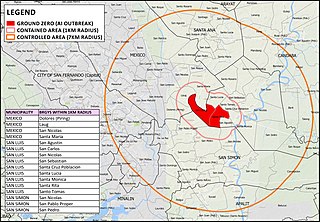
From April to September 2017 in the Philippines, an outbreak of H5N6 avian influenza or bird flu affected poultry in at least three towns in Central Luzon; San Luis in Pampanga and Jaen and San Isidro in Nueva Ecija.
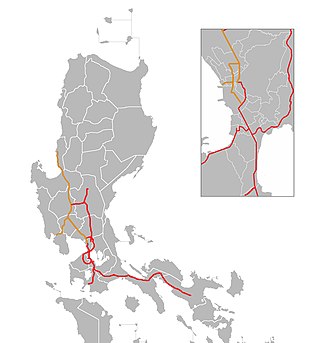
Expressway (E1) forms part of the Philippine expressway network. It runs through western Luzon from Quezon City in the south to Rosario in the north.
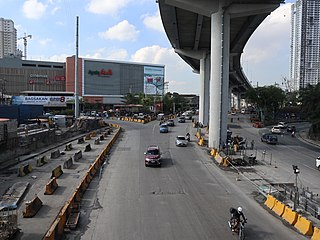
Balingasa, commonly known as Balintawak and Cloverleaf, is an administrative division in eastern Metro Manila, the Philippines. It is an urban barangay located in Quezon City, at the city's western boundary with Caloocan.

The COVID-19 pandemic in Central Luzon is part of the worldwide pandemic of coronavirus disease 2019 caused by severe acute respiratory syndrome coronavirus 2. The virus reached Central Luzon on March 9, 2020, when the first case of the disease was confirmed in San Jose del Monte. All provinces in the region have recorded COVID-19 cases. As of August 14, 2022. Central Luzon has 376,747 cases with 6,995 deaths.
References
- 1 2 Hog cholera reported in Bulacan [ permanent dead link ] By Carmela Reyes, the Philippine Daily Inquirer . 05:58pm 26 July 2007
- ↑ Hog cholera outbreak won't affect pork prices—Agri 27 July 2007
- ↑ DA issues order to curb hog cholera spread ABS-CBN News and Current Affairs
- ↑ Hog cholera outbreak under control—agri exec GMA News and Public Affairs. 30 July 2007
- ↑ Hog cholera in Bulacan, Pampanga contained by Marianne Go, the Philippine Star
- ↑ DA: Hog cholera outbreak now under control Philippine Information Agency
- ↑ Checkpoints set up to seize contaminated meat from Bulacan By Nancy C. Carvajal, TJ Burgonio, the Philippine Daily Inquirer . July 27, 2007
- ↑ Five tons of tainted meat seized in Balintawak market Archived 2007-08-22 at the Wayback Machine By Jefferson Antiporda, the Manila Times. August 02, 2007